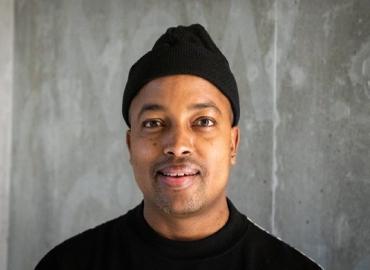
A&S alumnus Abdi Osman’s art explores intersections of Black and queer identities
See the original article on the Faculty of Arts & Science News Page, written by Sarah MacFarlane
For A&S alumnus and multidisciplinary artist Abdi Osman, there is no one-size-fits-all approach to creating art.
“I don’t like to limit myself or my talent to doing only one thing,” he says. “Not everything I create needs to be in one medium. I enjoy switching things up every now and then. I believe that some artworks are better represented in different mediums — some work well in video format, photography, audio, painting and drawing. I enjoy pushing myself to try new art-making methods. I don’t like to be monotonous.”
Osman’s work focuses on questions of Black masculinity as it intersects with Muslim and queer identities. His video and photography work has been shown in Canada and internationally in both group and solo exhibitions. Most recently, the 2022 Berlin International Film Festival featured Shadowboxing, Osman’s 2021 video installation exploring the gaps between experiences and representations of queer cruising, space- and place-making in Toronto.
“It felt amazing to have my work included at such a prestigious festival, where many people from around the world got to see it,” he says.
As an undergraduate student at the Faculty of Arts & Science, Osman studied African studies and environmental studies, earning his honours bachelor of arts in 2004 as a member of Woodsworth College.
“My undergraduate education continues to inspire and influence my art-making practice,” he says.
Experiences throughout his life have influenced his art, including his time as an outreach coordinator at Africans in Partnership Against AIDS (APAA).
“My experience working at APAA and my lived experience as a Black gay man play a role and are reflected in my art,” he says. “At the moment, I’m finishing up a short film I have been working on during the pandemic, which explores, frames and documents Toronto Black gay life across three conjunctural moments: life prior to HIV/AIDS, the midst of the pandemic and its aftermath. The project entails interviewing local Black gay men who lived through the pandemic through the optics of nightlife, sex and community. It will focus on one select figure who will recount and navigate the viewer through Toronto’s nightlife in the 1970s — before the advent of AIDS.”
Osman has maintained his connection to U of T throughout his career. He is a sessional lecturer in visual studies at the John H. Daniels Faculty of Architecture, Landscape, and Design. Last year, he joined the Community Leadership Residency Program at U of T’s Queer and Trans Research Lab, becoming part of the lab’s inaugural cohort of researchers, artists, community leaders, faculty and student research assistants.
Established in September 2021 at the Mark S. Bonham Centre for Sexual Diversity Studies, the Queer and Trans Research Lab is a collaborative research project focusing on methods in queer and trans studies across the disciplines as well as across creative, activist and scholarly research practices. The lab’s aim is to bring innovative approaches and solutions to social and political problems affecting LGBTQ2S+, Black, Indigenous and Racialized lives and communities.
“The community leader residency gave me the opportunity to work on my film and share my work in progress with students and the Queer and Trans Research Lab members,” Osman says.
He welcomes the return of in-person collaboration, since most of his work involves meeting, interacting with and spending time with collaborators. But even when the pandemic was restricting social interaction, he leaned into his ability to adapt.
“Like the artist I am, I didn’t let that affect me from producing art. During the lockdown, I turned to drawing and painting,” he says. “The pandemic disrupted my work but not my creativity.”

